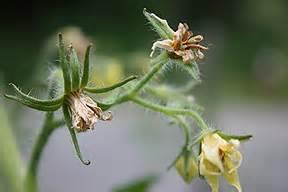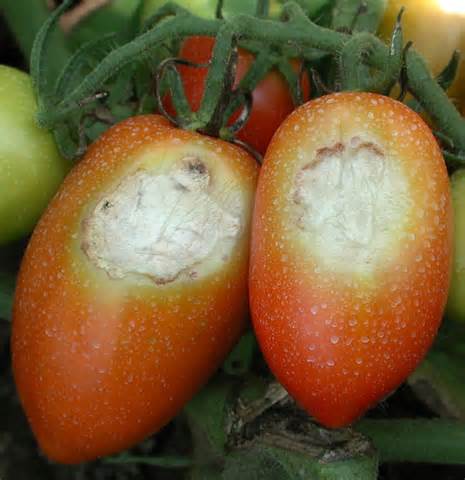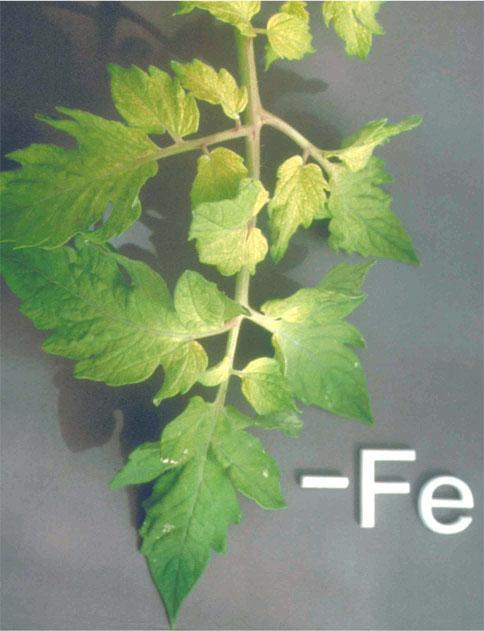Pests and Disorders
Pests and Disorders Content
Frequently tomatoes (and other vegetables) show symptoms similar to those caused by diseases or other pests. However, they may be caused by growing conditions rather than pest organisms.
Let’s mention a few environmental disorders, and realize three facts. One, that most home gardeners will likely NOT experience them. Two, some environmental disorders are conditions beyond the scope home gardeners can control. Three, those disorders that are within a home gardener’s control such as sunscald, frost damage, and water mismanagement are readily remedied.
Common environmental disorders include blossom drop, sunscald, cold injury and frost damage, lack of pollination, nutrient deficiencies, toxicities, and water mismanagement.
UC IPM has some remarks about these environmental conditions. See a complete list with photos and solutions at:
http://www.ipm.ucdavis.edu/PMG/GARDEN/VEGES/tomato.html

Blossom drop:
Blossoms that wilt and fall off the plant before setting fruit may be affected by a number of factors. For some plants, such as cucurbits, the flowers appearing first are male, which naturally drop. If later fruiting flowers drop in large numbers, it may be due to insufficient pollination. Other factors involved may be extremely high or low temperatures, insufficient soil moisture, or smog.

Sunscald:
Plants overexposed to direct sunlight can develop sunscald. Fruit can turn light brown or leathery and develop sunken areas. Leaves may appear scorched or discolored. Any practice that helps maintain sufficient leaf cover on plants will limit sunscald.

Cold injury and frost damage:
Cool and freezing temperatures may cause a number of symptoms. Plants may grow slowly or die. Pollination may be prevented, causing little or no fruit to develop. Fruit may be small, blistered, puckered (catfacing in tomatoes), and lack flavor or color. Leaves may be streaked, spotted, or wilted, and plants may flower prematurely, causing them to bolt. Plant to avoid cold and freezing injury. Cover susceptible plants when cold weather threatens.
Lack of pollination:
Poor pollination may be caused by a number of factors. Bees generally pollinate flowers of many vegetable plants. Rain, low light, or cold and hot temperatures can limit bee activity. Planting varieties not suited for your area or planting at the wrong time may also contribute to poor pollination. Depending on the vegetable, poorly pollinated plants may have fruit of normal color but are small and appear flat. Some fruit may appear shriveled or turn brown. Fruit that normally has seeds may have few or no seeds inside. Corn lacking in pollination may have shriveled or incompletely developed kernels. In other cases, no fruit sets at all.

Nutrient deficiencies:
Deficiencies can cause foliage to discolor, fade, distort, or become spotted. Fewer leaves, flowers, and fruit may be produced, and these may develop later than normal and remain undersized. Commercial laboratories can conduct foliage tests or soil analysis to verify deficiencies. Typical symptoms vary among vegetable species.

Toxicities:
Plants can be damaged by a number of toxic chemicals. Pollutants such as ozone may damage sensitive plants, causing leaves to die or become discolored.
Herbicides may cause plants to become spotted, develop necrotic areas, or become distorted. Glyphosate (Round up) acts rapidly with a yellowing or reddish purple discoloration developing on new growth. 2,4-D causes twisting of stems and distortion and crinkling of leaves.
An excess of minerals or nutrients can also cause damage. Plants may wilt, be stunted, become discolored, or appear scorched or brown around leaf margins.
Water mismanagement:
Mismanagement of water is a major contributing factor to many pest problems and also causes damage on its own. Too little water can result in small plants, poor root systems, and slower growth and exacerbates the effects of pests such as root nematodes that injure roots. Excessive water can contribute to the development of many diseases. Uneven distribution of water can encourage weeds and disease problems and prevent uniform maturing of the crop.
Home gardeners with vegetable and tomato problems they can’t identify or solve can bring them to the UC Master Gardeners of Napa office on Monday, Wednesday, and Friday between 9 am and noon. We WANT to talk to you—come on in!
